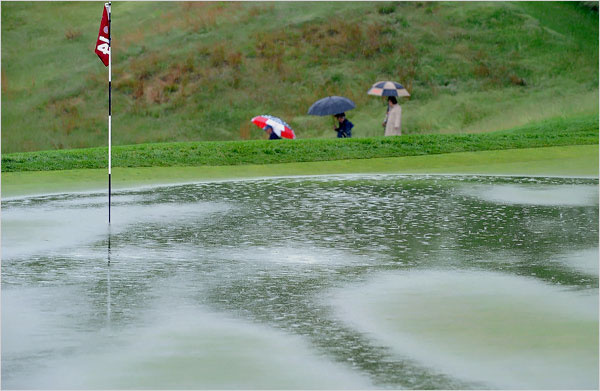Director's Corner
25 June 2009
The other kind of particle acceleration
Today's issue features a Director's Corner from Mike Harrison, GDE Americas Regional Director.
The ILC, when built, will represent the latest in technology innovation and will be a global effort involving world-class talent. The Accelerator Design and Integration meeting held at DESY a few weeks ago is an example of the design process in action. However, ensuring that we involve input from all relevant sources is part of a Regional Director’s job and, with this in mind, I found myself attending the first day of the US Open golf tournament, held this year a few miles down the road from my home institution of Brookhaven Laboratory at the famed Bethpage Black golf course. The particles being accelerated are rather bigger than those we are accustomed to; a golf ball has a diameter of 42.67 millimetres and weighs 45.93 grammes (these numbers make no sense in imperial units either). The acceleration technique of hitting the ‘particles’ with a wooden ‘club’ might not possess the refined elegance of a standing-wave superconducting radiofrequency (RF) cavity, but it does exhibit a certain visceral charm all of its own. Such raw particle acceleration might have more to do with wakefield technology than with linear colliders were it not for the fact that precision is also necessary. Requiring the ‘particle’ to reach the ‘interaction point’ or hole (107.95 millimetres in diameter) several hundred metres away might not excite the beam delivery experts with their five-nanometre target at the IP, but that does not mean that it is not without challenge. Given that the overall goal of the proceedings is to transport the ‘particle’ with the minimum number of ‘acceleration cycles’, the additional requirement for the highest possible accelerating gradients is clear. Power, precision and high gradients demonstrated by the top 150 global experts; how could the project fail to profit by my attending such a gathering?
 |
|
 |
|
| Americas Regional Director Mike Harrison get wet watching golf – and compares worlds. Images: Doug Mills/ Barton Silverman, The New York Times |
|
The first thing that becomes apparent upon arrival is the incredible preparation that takes place for such an event. The course has been transformed into a tent city in the space of a few weeks. The tent used for selling souvenirs was the largest one I had ever seen; certainly it was big enough to cover an interaction region (or two). The control system installed for the television networks was done without the benefit of cable tray but seemed perfectly content with the routing through the tall grass. These types of cost reduction technologies were seen everywhere and obviously lessons abound for the conventional facilities working group. The biggest moral here though is for project management. If we provided the economic stimulus of allowing the conventional facilities group to sell T-shirts for 50 dollars and 10-dollar beers, is it reasonable to ask them to complete the project in three weeks and handle a site visit from 50 000 people at the same time? I see no compelling drawbacks to this scheme.
Moving right along from the logistics we come to the question of the accelerating gradient. It is with evident frustration that one watches a global expert launch the particle 300 metres or so with their highest gradient accelerating cycle with what appears to be a relatively effortless motion. For those of you out there (assuming someone is still reading this) who have narrowly escaped permanent injury in attempting to approximate the same thing, the lesson is clear: operating margin. If you wish to move the particle 300 metres in a reliable fashion learn how to achieve 350 metres and then take something off it. This principle, well understood by my mother decades ago, provides the motivation for the superconducting RF R&D programme as we endeavour to ascertain the correct value between the maximum and operating cavity gradients. There is no discernable universal answer to this question so providing for individual performance variation, as we intend, would seem the correct way to proceed.
Precision continues to be an important topic. Large-amplitude particles, especially those involved with severely non-linear trajectories, will often be impacted by a silicon-based collimation system called 'bunkers'. While the silicon involved is amorphous not crystalline (regrets to those channeling aficionados out there), it is quite efficient. The random phase advance between these collimator elements does seem to lead to a less than uniform phase space on occasion. However, the dense grouping of collimators around the final focus, sometimes known by the environmentally friendly acronym of 'the green', is highly effective. It is also on 'the green' when alignment tolerances are at their tightest. While scarcely sub-micron alignment, the joy of watching an expert taking four putts from within 10 metres as I did, merely emphasises the critical importance of 'lining them up', in addition to providing an I-could-have-done-that-myself moment for the observers.
All good things must eventually come to an end but my day at the US Open was fated to end prematurely when torrential rain started and play was called off around noon for the day. Soaked to the skin, we retired to a more clement environment to further reflect on what we had learned. Obviously this line of research is promising and needs further investigation. Possibly the sport of cricket could be examined next to see what light it could shed on the issues associated with designing and building a linear collider, after all it rains a lot there too!
-- Mike Harrison
